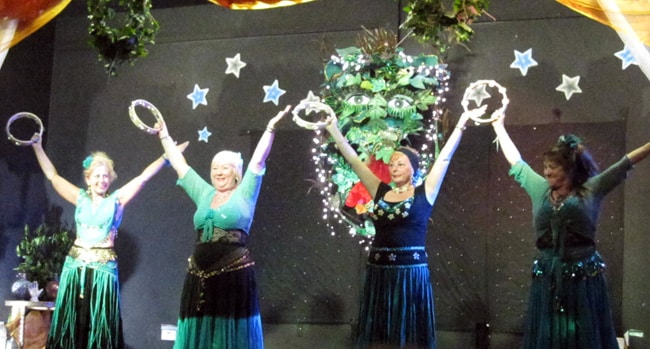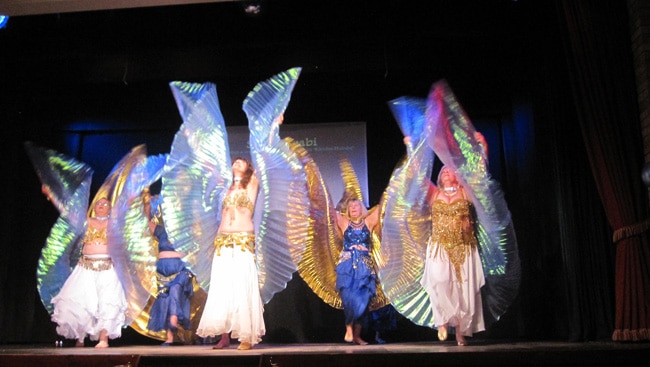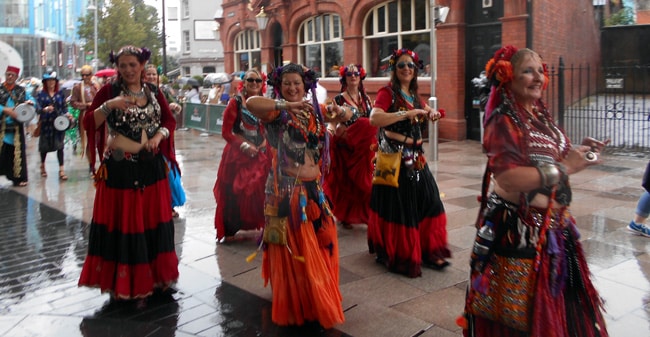Belly Dance and Mental Wellbeing
Last Updated on January 28, 2024

I recently read an article on Yahoo, which really made me think and inspired me to write this post.
The title of the article is “Belly Dancing Cured my Depression and Saved my Life” and I think many of you who practice this dance form would feel inspired by this.
My article below stems from my reflections on what is so special about this dance, what makes it especially healing and beneficial, not only for the body but also for the mind and soul (for the person as a whole, in fact).
By reading articles online written on this topic by other people, as well as academic papers and drawing also on information I got first hand from talking to other belly dancers, I have come up with a few possible reasons.
Please feel free to write to me or comment below, if you can think of more reasons or would like to share your experience.
Belly dance is not the only activity or dance genre that has healing properties.
In fact, you only need to think about trance dance and healing dances from all over the world, to see how humans have always used dance as a powerful healing tool.
For example, think of Zar from Egypt, guedra from Morocco, or Taranta from southern Italy.
These are all ritual dances that involve the healing of the person on a mental/ spiritual level. Nowadays, dance and movement therapy is the modern equivalent of these healing dances, where the ritual element has been replaced by psychotherapy concepts.
Movement in itself can help you feel in a better mood, because of the endorphins that are released, but there are other dimensions involved in dance, such as physical and emotional release and creativity, that can help.
Belly dance though has something special.
I would like to clarify that belly dance is not a substitute for psychotherapy or medical help, when that is needed, and the dance teacher is not a counselor.
However, many people seem to benefit from practicing belly dance.
I am using the term belly dance, for want of a better expression, to include different dance genres and styles, which are usually grouped under this umbrella.
These can range from Egyptian genres such as Raqs sharqi, Raqs Baladi and Shaabi, to Turkish oryantal, Lebanese Oriental, American oriental cabaret, and American tribal.
We could say, those dance genres that Andrea Deagon calls SITA (solo-improvised dance based on torso articulation).
My Own Experience
Before I start listing the elements that I think make belly dance special, with regards to being helpful in dealing with or preventing low mood, I would like to start with my own experience, as a testimonial.
I have always loved dancing, since I was a little child, growing up in Catania in Sicily, Italy, so much so that my childhood dream was to become a professional dancer.
When I was growing up in Catania in the 1970s/1980s, there were not many types of dance that I could practice, but ballet classes were available and I loved ballet as, to my little girl’s eyes, a ballerina represented the top of femininity and grace.
I did ballet from the age of 6 for about five years, but then I stopped, for a series of reasons.
First of all, when I was 11, I was diagnosed with scoliosis, which meant having to wear a corset for a couple of years, but also having to give up dance.
This was because, according to the doctor who was following me, all dance, but ballet especially, was bad for the back (however, when I was in my thirties, I discovered belly dance and I found that this type of dance was in fact good for my back, as I mentioned in another post).
I was supposed to do swimming instead, which I hated (although now I almost like it) and I disliked every other sport at the time.
Another reason why I stopped ballet was that, somehow, after a few years it did not inspire me anymore.
Even as a child, I liked improvising when dancing and having as much creative freedom with dance as I could.
However, there is no improvisation in classical ballet, and traditionally dancers did not have any input in creating the choreography (although this may be changing now, with contemporary ballet productions).
If there had been contemporary dance classes in Sicily when I was growing up, I probably would have loved them, as I would have loved belly dancing.
But there were none of these things. Also, my parents did not encourage me to take up dance as a career, nor even as a serious hobby.
Apart from the concerns for my back, after what the doctor told them, it was because they thought that it was almost impossible to make it as a dancer and I would have faced a life of unemployment had I chosen that path.
Anyway, probably it was not too bad that I had to stop ballet because, from the age of 12, my body started to shape as a woman, and would have not fit the ideal image of a thin ballerina.
So, I practiced a bit of jazz and afro dance after that, but nothing grabbed my attention as much as belly dance did when I was in my early thirties.
It was everything I had always sought in dance!
I loved the music (as I always did even before trying belly dance), I loved the way my body felt when dancing, I loved the fact that I could improvise, it made me feel happy and confident and also the movements felt so natural and right for a woman’s body.
So, I started practicing it and never stopped.
A few years later, when I turned 40, I went through the typical mid-life crisis.
I found myself re-evaluating and reflecting on my life and what I wanted out of it in the future.
I also felt a bit down because I did not really like my job anymore.
My heart was not in it, as I did not find it stimulating or creative enough.
This is when having a passion such as belly dance came to my rescue, because it gave me an outlet to channel my creativity.
The fact that this dance form can be practiced at any age no matter how old you are, was a good thing, as it meant that I did not feel too old to continue.
Also, I decided to do a Ph.D. on Egyptian raqs sharqi as a form of cultural heritage, to bring together my academic background in humanities and cultural heritage, with my love for dance.
My next aim is to find employment in academia, teaching subjects to do with dance and culture, and researching in the fields of dance and humanities.
On top of that, I want to continue being involved in teaching and performing oriental dance.
I know that finding a job in academia is not an easy task, but I am trying hard by networking and writing academic articles, so I hope to achieve my goal.
Also, doing a Ph.D. has given me the mental challenge I needed to get back on track and, I must add, my husband’s support in all of this has been invaluable!
The point of all this is that, basically, there is always hope.
It does not even matter how old you are. If you love to dance, this art form can always be present in your life one way or another and it can be a powerful tool to help you lift your mood and find a purpose in life.
Belly dance, in particular, is maybe even more helpful than other dance genres for this.

Practitioners’ Opinions and Expressing Emotions in Dance
I have spoken to many oriental dance practitioners throughout the years, including during past research projects in Egypt.
I am not quoting anyone in particular here, but I think that there is a general consensus among them, with regards to how empowering this dance can be.
Dancers often mention how much more confident oriental dance makes them feel, and some of them mention the healing powers of this dance.
They all often say that they love the music and also that they love the fact that Raqs sharqi allows them to express their emotions and their individuality.
They see this dance as something positive, fun, and through which they can funnel all their emotions and their personality, without caring if they are being judged.
A lot of belly dancers may already have the idea that this is the case, but it is interesting to hear these ideas over and over again.
A common agreement is also the fact that in oriental dance, or belly dance, feelings and expressing emotions is vital.
Many people agree that technique is an instrument, a tool to express themselves, but, without feeling, technique becomes pointless.
Expressing emotions is important in most dance genres, I think, but with oriental dance, there is an even deeper connection, it seems, between the dance and the very personal inner dimension of individual dancers.
I think that this is one of the elements that make belly dance so powerful as a healing force.
Basically, oriental dance comes from the heart and this makes people feel powerful and mentally freer.
Please feel free to contact me or to comment to express your opinion, as it will be very interesting to hear from you, whether you agree or disagree with these points.
Sense of Community
Another element that seems very important that emerges from what I read and the things I have been told by other practitioners, is how important the community is in belly dance. People who practice this dance form often feel part of a bigger community.
Unfortunately, not all belly dancers may be supportive and some may feel competitive. After all, these dancers are humans too!
However, very often the belly dance community offers a very supportive environment.
I have been told, by people who practiced other dance forms, that the community element is more present in belly dance than in other genres they were involved in.
The key is finding the right teacher and a sympathetic and warm, rather than competitive class environment.
I found, throughout the years, that I got to know a lot of interesting people through attending belly dance classes, workshops, hafla, and trips.
People who practice this dance genre are usually very strong-minded, inquisitive, and open-minded.
At least that is what I found so far in the majority of cases, or maybe I have just been lucky up until now!
It goes without saying that connecting socially with each other is vital to keep people mentally strong and engaged.
Self-Esteem and Body Image
Because belly dancing is not associated with a specific body type, dancers do not feel under pressure to conform to an ideal image.
Every shape and size is welcome and people feel happier in their skin.
This idea is supported by a recent academic study (Tiggemann et al, 2014), which investigates the perception of body image and satisfaction between belly dancers and practitioners of other dance genres.
The findings show that the percentage of body image satisfaction is much higher amongst belly dancers.
Feeling good in your body is a necessary foundation for good self-esteem, which leads to feeling more confident overall and more able to cope with life’s difficulties.
Resources and Further Reading
Books
Alia Thabit is writing a book about the soul of belly dance. This is titled Midnight at the Crossroads: Has belly dance sold its soul? The book has not been published yet, at the time of writing this post, but I look forward to reading it.
Another very interesting book is one by Joana Saahira, who lived and performed professionally in Egypt for several years. The book is about her experience in Egypt, as a dancer but also her development as a person. The title is The Secrets of Egypt – Dance, Life & Beyond.
Links to Other Sites
The Gilded Serpent has many interesting articles about belly dance and several about mental issues. See, for example, the article by Adry Svraka Dancing Makes Us Beautiful and Depression Free.
Articles on This Site
If you like this article, you may also be interested in reading the following posts I wrote:
- Stories of resilience and solidarity
- Dancing after the age of 50 and beyond
- Article on dance therapy
- Another article on belly dance and therapy
- Health benefits of belly dance
Academic Articles
Abrão, Ana Carla Peto, and Luiz Jorge Pedrão. 2005. “The contribution of belly dance to body education, physical and mental health of women who go to the gym or dance.” Revista latino-americana de enfermagem 13 (2):243-248.
Baptista, AS, AL Villela, A Jones, and J Natour. 2012. “Effectiveness of dance in patients with fibromyalgia: A randomised, single-blind, controlled study.” Clin Exp Rheumatol 30 (6 Suppl 74):18-23.
De Leon, Nadia. 2006. “Belly Dance as a Means of Dance Therapy for Survivors of Sexual Assault.” Western Kentucky University.
Moe, Angela M. 2014. “Healing Through Movement: The Benefits of Belly Dance for Gendered Victimization.” Affilia 29 (3):326-339.
Tiggemann, Marika, Emily Couts, and Levina Clark. 2014. “Belly Dance as an Embodying Activity? A Test of the Embodiment Model of Positive Body Image.” Sexs Roles 71 (5):197-207.
Latest posts by Dr Valeria Lo Iacono (see all)
- Belly Dancing over the Age of 40, 50 and Beyond - January 21, 2024
- Health Benefits of Belly Dance - January 20, 2024
- 10 Countries for Learning Belly Dance - January 18, 2024

















